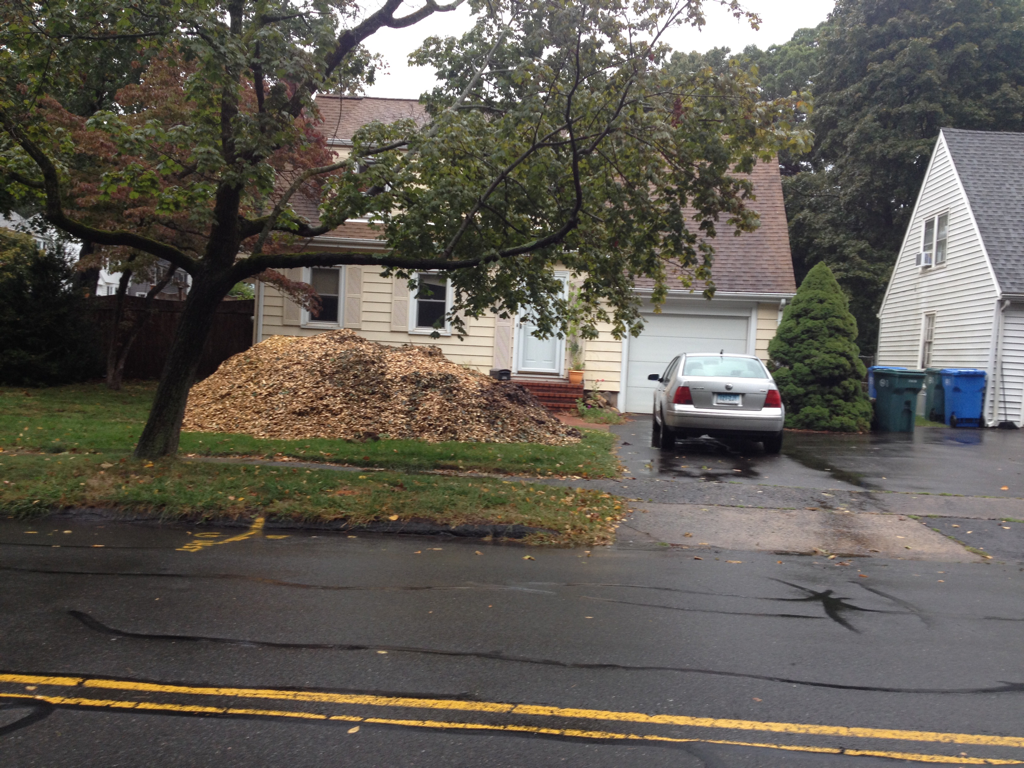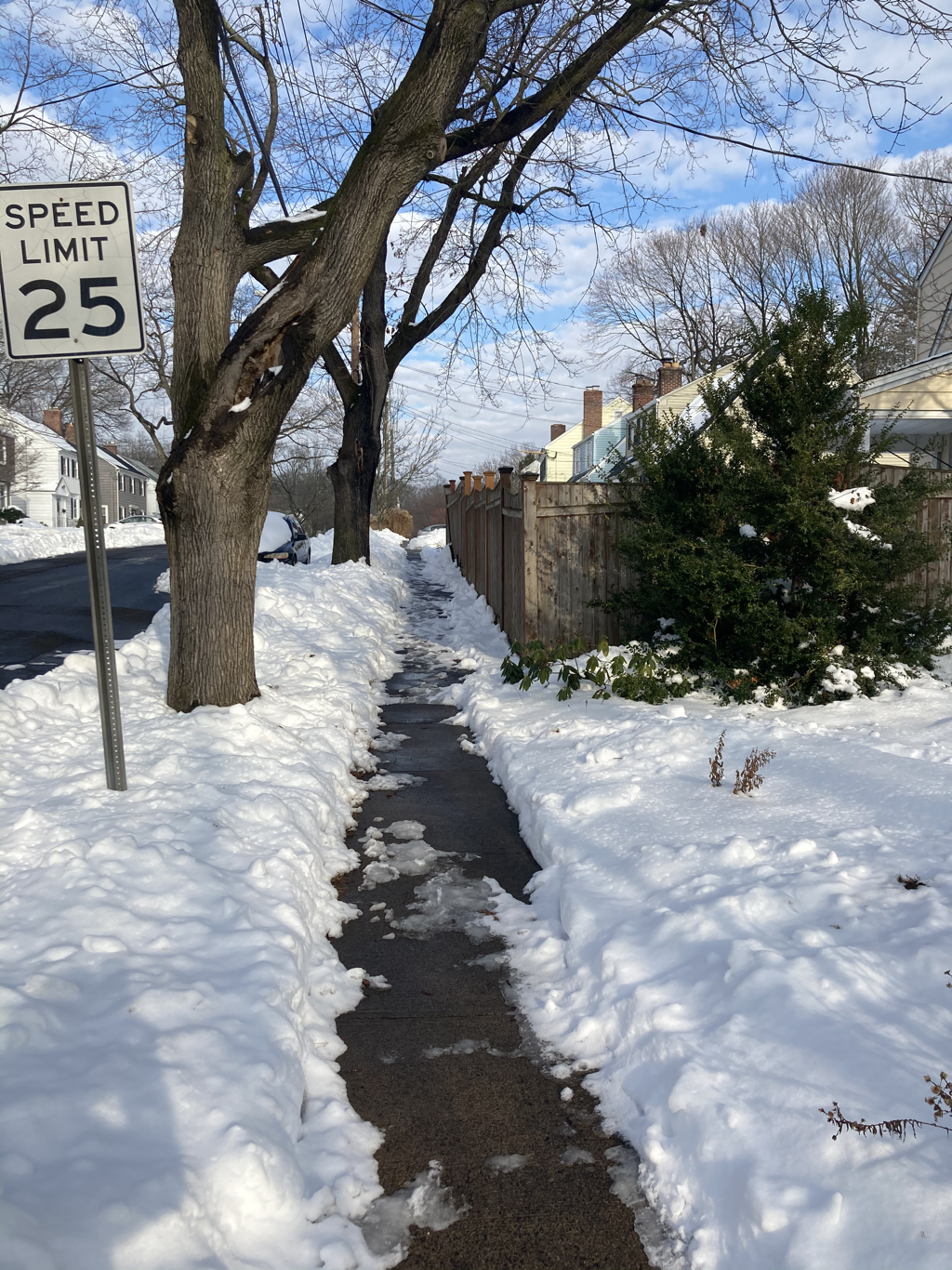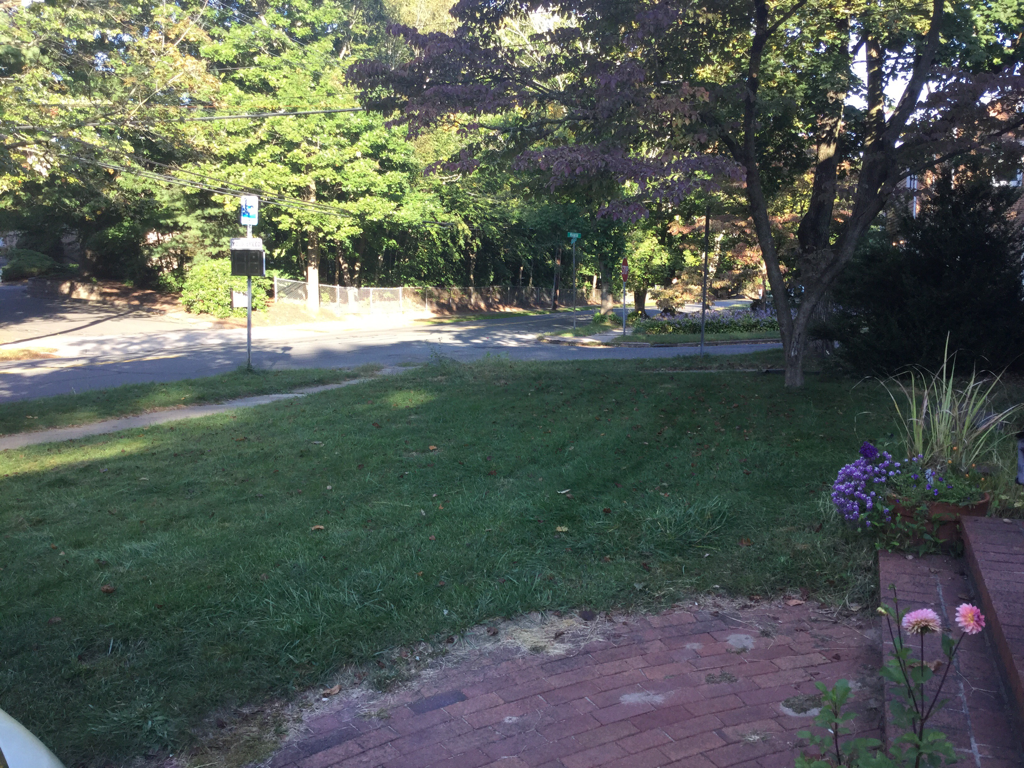|
Still to come is a more detailed post about what we’ve discovered about remediating a non-organic lawn. HOWEVER, I felt I needed to share what we’ve got going on now. Adam got involved in the whole process, and he is a do-er while I am a thinker, so he got a load of wood chips delivered. The idea is to add organic matter to the soil. We’ve been squirreling these chips away to various places in the yard—burying them in the ground, making piles, etc.
The worst part are all the comments from the neighbors. People give us horrified looks and say “that’s a lot of work”. We’ve been asked if there’s a hobbit under there. I get the reference, but that literally makes no sense. The best part is the steam rising from the top, which means it’s cooking away in there, like a good compost pile should! Actually, the true best part is that our yard is already a more interesting place with our piles and trenches. Whacky, bizarre, unconventional, yes. But there is a REASON to go out to the front yard, which there never was before. I suppose the lesson is that ANYTHING is more interesting than a “perfect” lawn.
1 Comment
The first step when you realize your lawn has chemicals and heavy metals in it is not to panic. Most people get land that is contaminated in some way, unless you clear cut the woods to build your house, which you shouldn't have done. I believe that we will need to learn how to grow food on imperfect soil, so I kind of welcome this challenge as a learning experience. One of Adam's acquaintances is a soil remediation expert, so after talking to him and doing some research of our own, here is what we've learned about nursing chemical-ridden land back to life.
Do a soil test Know what's in your soil and in what quantities. Uconn tests for lead only, and Umass tests for lead, other metals, and optional add-ons. These tests cost money, $12 and $60 respectively. I sampled both front and back yards separately, which was useful, because they have different metal levels. Lead was low, and arsenic was 5mg in back and 15mg in front. I suspected this was due to more concentrated pesticide use in front. As to safe arsenic levels, scientists are thoroughly in disagreement. Every state in the US has safe limits, and they range from 2mg to 40mg. Once I found that out, I threw my hands up and decided we were ok. The soil expert said that the Umass test might be slightly inaccurate, but an accurate result could make you legally responsible for remediating the soil, which is expensive. So Uconn and Umass are great ways to generally know what's in your soil. Raised beds are key The soil expert was much more concerned about lead and arsenic in the soil than the historical use of Grub Ex and pesticides. He said that those substances didn't affect adult humans as much (So you can finally use that Grub Ex slip'n'slide) but arsenic and lead are dangerous. He said raised beds only 10 inches high are a safe level away from the soil. He even grows potatoes in his raised beds. The conclusion I would make from that is that it's ok to have children dig around in raised beds, but probably not in the soil if you know it's particularly contaminated. Or at least have them wash their hands when they come in from playing. Hey, you should wash your hands too. Choose your food crops Lead and metals concentrate mainly in root crops, somewhat in leaf crops, and less so in fruits. So if you are concerned, grow something like tomatoes or peppers. Acidic soil makes metals more bioavailable for plants to absorb. However, if you're using a raised bed, this shouldn't be much of an issue. Avoid old house foundations Grow food at least three feet from old house foundations. There could be lead chips from paint there. He told a story about a person who power washed their old house and lead chips bounced into the neighbor's yard, poisoning their child. Which is not to freak you out, but just something to think about. And molecules of heavy metals persist in the environment. Even if we rototill to loosen the soil, the lead and arsenic will bounce out, maybe onto the sidewalk, and will likely find their way back into our soil. It is simply a fact of the world we've all inherited. Alleviate compaction Compaction is possible from years of tractors and people walking over it. Ours is extremely solid. If you want to keep your lawn, you can rent an aerator, which alleviates this. If you want to plant gardens, you can rototill or manually turn over the soil. Most organic gardening experts oppose tillage of any kind; It fragments earthworm tunnels, destroys the structure of the soil, releases carbon into the atmosphere, and churns the living topsoil into the subsoil, where it dies. Guess what? Chemical lawn treatments kill all of this life anyway, so your microbes are dead, and your soil structure is likely garbage as a result. So relieve that compaction by tilling before you start your organic garden. You'll create such a wonderful environment that microbes and worms will move back in. Add organic matter A chemical lawn is an IV drip for the grass. The soil is totally ignored, even though it is the most important element in growing healthy plants. Soil must be fed. Season after season of pushing grass up with no food will leave soil starved. You'll need to feed the soil with grass clippings, compost, chopped leaves, or aged manure. Our organic matter of choice was a humongous pile of wood chips, which we intend to compost and add to the soil. We chose this because we want to make wood chip paths through the yard as well, and we also want the entire neighborhood to know that we're maniacs. Ok, so there are some tips if you are worried about what you or someone else has done to you soil by using Scotts 4 Step, or Weed n' Feed, or a lawn service that is not organic. And if you live in a city or suburb, industry or pollutants could have made their way into your soil. Take that soil test to determine what they are and take the above precautions. A few nights ago, I visited the previous owners of this house in their new home. They want to move the butterfly bushes and a small tree from our yard into theirs, but have no idea where to put them, so they asked me to come take a look. It was the woman and her sister and they basically got a low-rent landscape design consultation plus an abbreviated version of the organic lawn talk I did last weekend.
The woman asked me what I planned to do with the yard, and something in me didn’t want to really tell her, but I’m glad I did. I said I planned to plant fruit trees and vegetables. Her face got serious. “I don’t know if you want to do that. My husband put a lot of nasty stuff down on that lawn.” “Like Weed and Feed?” “No, toxic stuff, like Grub-Ex.” I thanked her for telling me. I suppose I should find out exactly what went into that soil, though in the moment I really did not want to know. I’ll let the disappointment hit in small amounts, not all at once. I imagined there was nasty stuff in the soil, I just didn’t want to admit it. I have never seen a worm or grub or really anything in the soil. But I’m not going to let that stop me. I still fully intend to go through with my yard plan. I can’t accept a world where every suburban lawn is poisoned beyond use, just because it was once stewarded by some brainwashed person who knew nothing about plants. Plus, there’s no guarantee that the food we buy has been grown in pristine soil. Without researching anything, here’s what I know: —Fruit trees will probably be fine. Metals and toxins concentrate in the roots and leaves of plants more than in the fruits. This goes for vegetables as well. Fruiting vegetables are safer to plant in questionable areas than root or leaf crops. I will certainly not be planting vegetables soon, however. —Metals and chemicals have a harder time seeping into plants when the organic matter in the soil is high. This means adding manure, chopped leaves, compost, etc. —The UMASS toxic soil test I did in the spring revealed medium lead levels, and an arsenic reading of 15 in front, 5 in back. Research on this turned up inconclusive results. There is no national safe arsenic threshold; in some states it’s 2 and in some states it’s 40. Arsenic also leaches out of rock, so some mountain soils have very high levels. I had abandoned this line of inquiry, but maybe I’ll pick it up again. —Adam is obsessed with mushrooms right now and I know there are some that can remediate contaminated soils. Maybe I can just turn him loose on the lawn. One husband will wreck it and one husband will revive it. —How will I know the soils are coming back to life? I will see worms and bugs, and the birds will stop in my yard. (They all fly by now. Even squirrels don’t stop.) Update: Found out what he put on the lawn. Pesticide/Fertilizer twice a year, Grub Ex three times a year, and of course the fire of a thousand demons because how else are you supposed to keep your short green plants from joining the ecosystem? Now before we get mad or pass judgement, know that the moles forced him to do it. And as we all know, moles are so mean. Have you seen the mole twitter handle? @moletalk? It cuts like a knife and no one is safe. So really this problem is because of the moles. Cold hearted, vicious soil-aerators. In planning my yard, I’m using permaculture principles. People are often familiar with the term “permaculture” but don’t understand what it means. Here is my explanation.
Imagine an acre of corn. What do you get from it? Corn. Who does it feed? Humans, who only want to eat corn. Now imagine that acre planted with fruit and nut trees, berry bushes, and perennial vegetables, like asparagus or perennial leafy greens. Throw in some flowers to attract bees and some chickens to forage dropped fruit. What do you get from it? A varied and healthy diet. Who does it feed? Humans, insects, spiders, birds, rabbits, mice, foxes—basically anything that lives in the ecosystem. This is the idea behind food forests, a basic principle of permaculture. You get maximum food output from crops that come back every year, without the intense work and fertility that must go into an annual vegetable garden. I think it is a viable solution for many of our environmental problems. Bill Mollison, the founder of permaculture, says that humans must return all land not necessary to food production to wildlife. With intense cropping like this, we could let a lot of land grow wild. The other major part of permaculture is designing buildings to be efficient and work with natural forces. A few examples: siting buildings properly according to climate, harvesting rainwater, and placing gardens near the home so that maintaining them is easier. As far as the buildings go, we would have to retrofit our house, and we are thinking about doing that for rainwater harvesting. Big project. It is on the back burner. Good design makes life easy and uses minimal energy. Buildings should be constructed to use energy efficiently, and your yard should be laid out to use your energy efficiently. For example—a vegetable garden is a high maintenance operation, so don’t put it, say, in the town you used to live in. You won’t take good care of it. (But you planted flowers, which fools everyone into thinking it looks great). Put a vegetable garden right outside your front door, where you can tend it briefly as you go in and out. I always think about the proverb that I saw somewhere: “The best fertilizer is the gardener’s footsteps”. Those are the basics. If you want to get more in depth, here are some recommendations: A Designer’s Manual, Bill Mollison—I ordered it on inter library loan, and I’m pretty sure the librarian watched my face fall as he handed me what looked exactly like a high school science textbook. Probably 40% of this book went over my head, but the rest made me write “woooaahhh” in the margins in pencil. I was late returning it because I had to erase them all. He shares ideas on how our lives on this planet should look, and gives us some guidance on how to get there. Practical Permaculture, Jessi Bloom—This is the book that I read years ago when I decided to find an answer for the question “what is permaculture?” Does a pretty good job answering it, and is easier to read and implement than Bill Mollison’s book. Youtube tours of food forests—I like Rob Avis’s videos. There’s also one called something like “Tour of a Temperate Climate Food Forest” with a lady who does a good job explaining her plants. Lots of videos are stupid. Like, 9 in 10 are stupid. So be careful. And the book I’m reading now is called Creating a Forest Garden by Martin Crawford. It tells you exactly how to do everything, and I’m loving it. A great practical guide to help you avoid mistakes and to steer you towards success. |
Categories
All
Archives
August 2021
|
Proudly powered by Weebly



 RSS Feed
RSS Feed